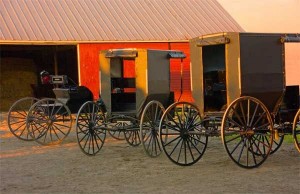The Amish
I watched the WGBH-produced film “The Amish” on PBS last night. Here’s the link to the PBS page, and conversation, about the film. And here’s a link to an article in Salon about the program. The title of this article uses the word “zealot”–which troubles me because the Amish do not proselytize, a practice I think intrinsic to true religious zealots.
I read many of the viewer comments on the PBS site and was shocked at the degree of animosity expressed by people who live near Amish settlements. If I had one criticism of the film it was that it wasn’t deep enough, and didn’t make it clear how varied the lifestyles of different Amish “churches” can be. Here in the North Country, for example, we have many Amish families who adhere to the strictest, or most conservative, practices, unlike those who live in Pennsylvania.
One of our local scholars, Karen Johnson-Weiner of SUNY Potsdam, was featured on the program. Karen has studied Amish communities and written extensively about them, including her book, “New York Amish,” a highly-regarded work that was published about a year ago.
Please share your stories about living near, working or interacting with Amish people in your communities.









Don’t paint Pennsylvania Amish as different than those in the north country. To do so is to notice only those of a few Pennsylvania congregations and most likely in the Lancaster area. There are Amish across the state and many as conservative as those in say the Huvelton area which are perhaps a little more conservative than those in the Lowville area who hail from the Maryland/Pennsylvania border. Amish move for land and for Ordenung issues- differences of opinion or desires. Maybe Jakey and Sam and Ruben want to have a stationary tractor but the ministers don’t allow it. They find some friends who believe alike and set out to move somewhere to establish a new congregation. Some allow buttons some not; some two suspender straps in the back some one and some one strap over the shoulder. Some white shirts and brown pants and coats only others single color shirts. Hat type varies too. About as varied as Peter Pan collar decorations in a Catholic Girls school. And too, many seen in the Lancaster, PA area are actually Mennonites who do not drive automobiles, as opposed to black bumper Mennonites. And while the program spoke of the Swartzentruber Amish, one can look elsewhere and find a similar group under a different leader.
I thought the program did a good job in the time it had to cover a lot of bases- including the clashes between government and issues they believe interfere with their religion. Don Kraybil works mostly in the Lancaster, PA. region. Amish friends of my friends don’t mind pictures taken of their children. One of my brothers-in-law works as a landscaper for an Amish contractor. Some may have heard the one speaker comment, and I can’t remember his words, that they were not certain of salvation and that is different from most Catholic and protestant teaching. There is a sense to me, from the program and other material I have read, that their manner of dress is in part a means of guiding their path- setting boundaries as it was mentioned. The cape dress for instance is for modesty as is sleeve length to cover the elbow in the women’s dresses- to diminish temptation for the men…. The coverings and hats are there for the same reason Jewish men or Catholic women cover their heads.
The Amish I’ve met are intelligent and certainly hard working. Bishops are known to speak to a member if their homestead is unkempt- again that depends on the congregation, not out of pride but of testimony. I think many “English” are prejudiced believing that with their limited education they are backward. As was mentioned, farms in Lancaster County go for $10,000 an acre. Takes some horse sense to buy a farm there. A friend of our family, not Amish, had $250,000 loaned out through the Amish community near him to many people. The Bishop was the one to say, we’ll back the loan if so and so doesn’t make good.